The Evergreen Content Engine – A Complete Guide to Creating Content That Keeps Giving
Tired of the content hamster wheel?
Imagine creating trending content as a content creator for a blog or a company.
Now, it may perform seasonally or as long as the trend is alive! It feels unfair, right?
Evergreen content is the alternative that is worth your time!
Trust me- I know. I have been creating content for the past 7 years for businesses, e-commerce sites, marketplaces, SaaS, and personal websites! And my most successful content marketing campaigns were always evergreen content pieces. They will stay valid and perform for a longer time- driving clicks and conversions(sales).
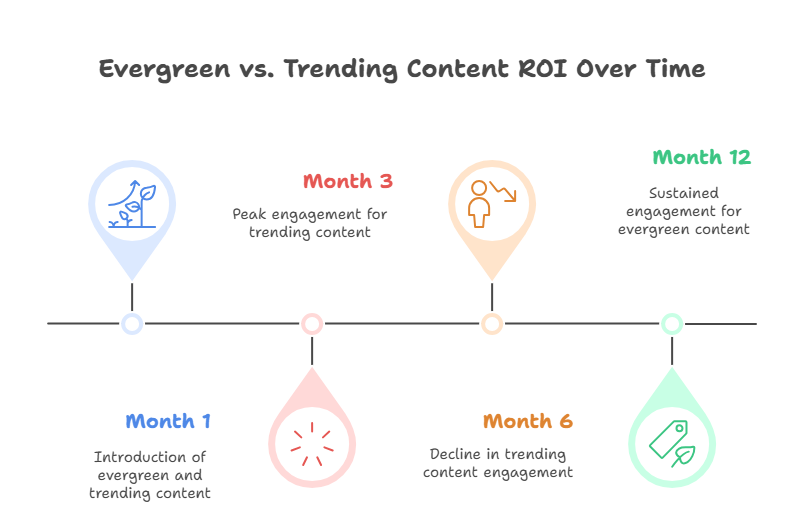
Unlike churning out content every other day on fleeting trends that quickly lose steam, evergreen content builds lasting value, much like compound interest steadily grows your savings over time.
Marketers out there are recognizing the power of evergreen content in battling the changing search algorithm landscape. Not only does it offer a chance to deliver stronger ROI(Return on Investment), but it also makes content creation less tiresome.
What is Evergreen Content really?
Page Contents
Definition: Evergreen content is valuable information that stays relevant over time.
It’s more than just content that doesn’t expire. Evergreen content brings in traffic without depending too much on what’s trending right now.
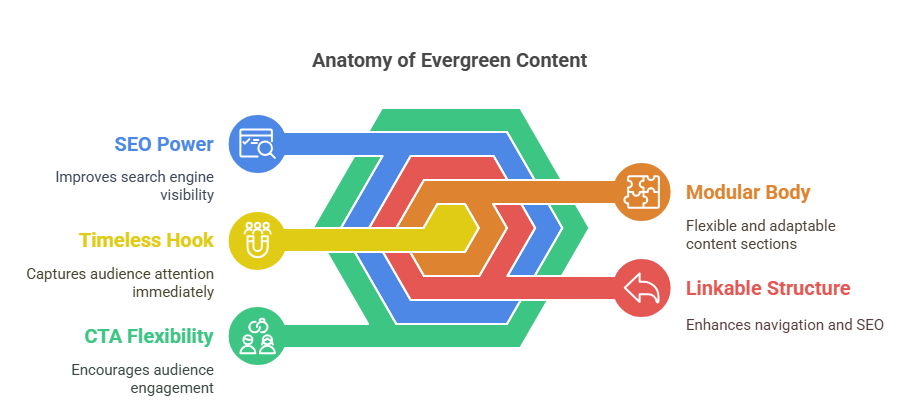
Think of it as a system that includes timeless topics, lasting content formats, and scalable frameworks to consistently satisfy ‘core intent.’
Evergreen content serves this core intent- the fundamental needs and questions people have year after year—rather than just “topical intent” or trending topics.
The 4 Content Pillars of the Evergreen Engine
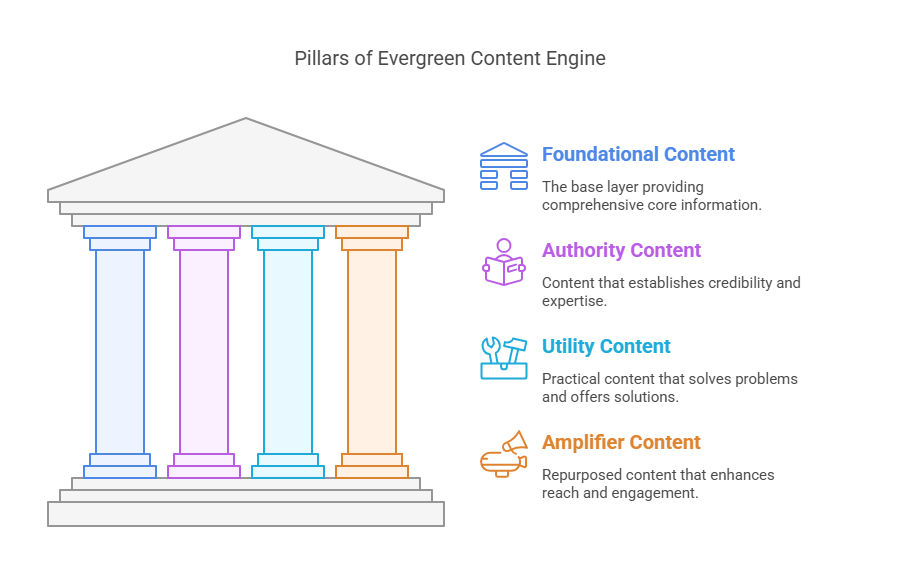
To effectively leverage the power of evergreen content, it’s essential to adopt a structured approach. We propose a framework built on four key content types:
- Foundational Content: This forms the bedrock of your evergreen content strategy. It consists of in-depth, comprehensive pieces that cover core topics relevant to your audience. Think of long-form blog posts, comprehensive guides, and detailed explainer videos. These pieces should be well-researched, informative, and optimized for search.
- Authority Content: This content positions you as a thought leader in your industry. It involves sharing your unique insights, perspectives, and expertise on trending topics or controversial issues. This could include blog posts, white papers, webinars, or even podcasts. Authority content establishes your credibility and attracts a loyal following of engaged readers.
- Utility Content: This type of content provides practical value to your audience. It could include templates, checklists, calculators, or other resources that solve problems. Utility content demonstrates your commitment to helping your audience and encourages them to return to your website for future needs.
- Amplifier Content: This involves repurposing existing content into shorter, more digestible formats. This could include creating social media posts, video snippets, or infographics based on your blog posts or articles. Amplifier content helps you reach a wider audience and extend the reach of your evergreen content.
How to Find Evergreen Topics in Any Niche
Uncovering Evergreen Content Ideas
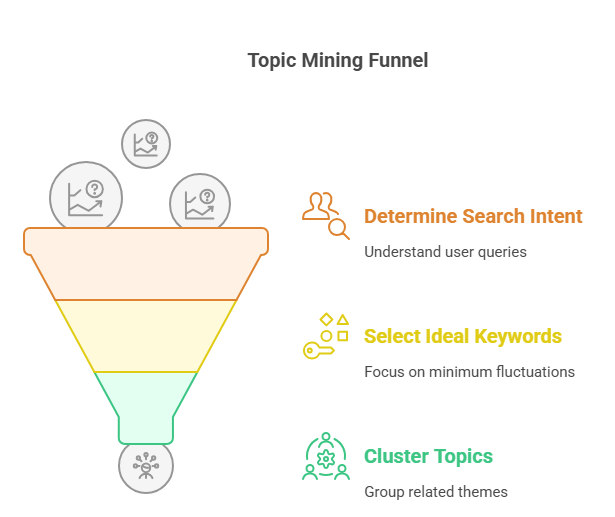
Finding evergreen content ideas is not just about keyword research- but about finding out the needs of your target audience. Here are some practical steps to uncover evergreen gems without breaking a sweat. You can use these to find evergreen topics for any niche.
- Intent-Focused Keyword Research: Unlike traditional keyword research, going for high-volume keywords will not give you the best content that performs throughout its lifetime. In the age of AI and new search algorithms, what you need is to focus on intent first. Understand the ‘why’ behind the audience searching for a topic. Google Suggest, aka Autocomplete, and AnswerThePublic are tools that can help you pinpoint the questions and problems that your readers are facing.
- Low Volatility, High Volume: Once you have identified the correct user intent, filter out the keywords that have high volume and less fluctuations. For example, you can use Google Trends to find the volatility of a keyword throughout the year. Opt for keywords that don’t have any seasonal fluctuations or drops based on trends.
- Long-Tail Keyword Clusters: From the set of keywords you have collected so far, break them down to long-tail keywords…pun intended. Target long-tail keywords that target very specific problems of your readers. Once you have this targeted content created, create a cluster of these long-tail keyword topics. Grouping these will build your authority on this specific topic.
Content Blueprinting: Structure Evergreen for Scalability
A Blueprint for Evergreen Content Format
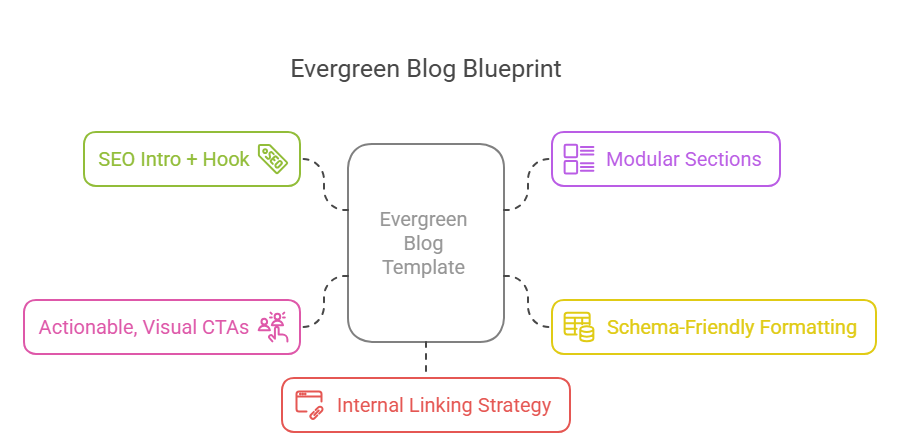
Creating evergreen content is not just about research and writing but also about editing and formatting. Make sure the way you arrange information and text is easy to scale over time. Here’s a blueprint for creating an evergreen content format:
- Hook the audience: Start with a catchy intro that clearly conveys what is about to follow. Make sure you start in a way that will hook the reader’s attention. Also, SEO-optimize the introduction by adding the target keyword to the intro.
- Break down sections: Large blocks of text are hard to read and understand. Break content into sections, adding headings, subheadings, images, and bullet points where required. This will also help update and scale the content later. For instance, if there is a large set of numerical data, instead of explaining it in words, create a graph or infographic.
- Link to related content: Add links to other contextually similar pages on your website. Such links are called Internal links. This strategy of internal linking can improve user experience and pass one page’s authority to the next. Such interconnected pages are ideal for passing your message completely to the user and giving them a comprehensive resource about the topic you write about.
Repurpose & Refresh: Making Evergreen Work 10x Harder
Maximizing the Impact of Evergreen Content
Evergreen content will not perform well if you publish and forget about it. What if it does not perform as well as you imagined? Here are two ways to get the most out of the time and effort you put into creating the content.
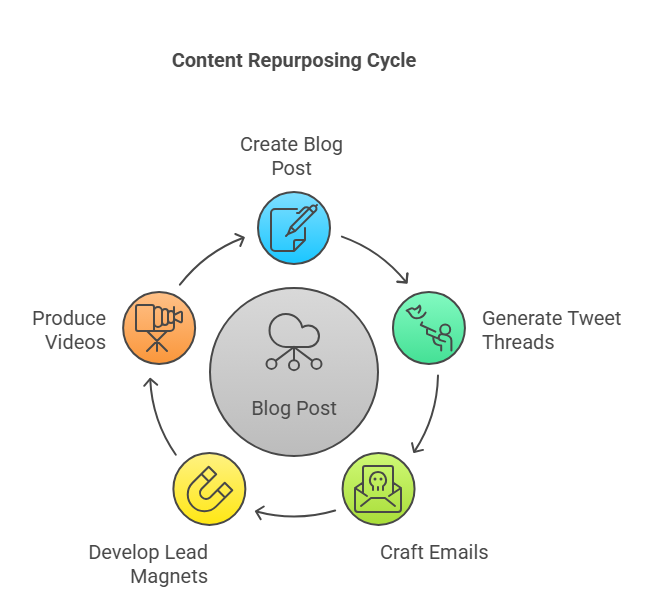
Update your content: Set strict time intervals where you review the performance of your content. I do performance reviews for my blogs every month and note down any considerable changes in traffic and other factors. Every six months, I will make changes to my evergreen content- adding new paragraphs, creating more links, and maybe tweaking the format.
Repurpose your content: If you have long-form content, repurpose it to create social media posts, video content, infographics, and even an email series. Even when your blog traffic dips, the short-form content will still get you the attention you need!
How to Measure the ROI of Evergreen Content
Tracking the Success of Evergreen Content
To measure the ROI of your evergreen content, monitor these key performance indicators (KPIs):
- Traffic Over Time: Track organic traffic to your evergreen content over 90, 180, and 365 days to assess its long-term performance.
- Backlink Accumulation: Monitor the number and quality of backlinks pointing to your evergreen content. Backlinks are a strong indicator of authority and can significantly impact your search rankings.
- Ranking Stability: Track your content’s search engine rankings over time to ensure it maintains a strong position for your target keywords.
- Lead Attribution: Monitor the number of leads generated from your evergreen content. Keeping track of this data will help you gain an idea of your content’s impact on business goals.
- Time-on-Page Longevity: Track the average time users spend on your evergreen content. This metric can indicate how engaging and valuable your content is to your audience.
Tools & Templates to Build Your Own Evergreen Engine
Essential Tools for Evergreen Content Creation

Here are some tools and resources to help you streamline your evergreen content creation process:
- Content Management Systems: Platforms like WordPress or HubSpot provide the foundation for creating, publishing, and managing your content.
- Keyword Research Tools: There are many tools in the market, including Semrush and Ahrefs (I use both of these), which not only help you find the ideal keywords but also track your site’s performance.
- Content Optimization Tools: To get your content ready for search engines and your audience, use solutions like Surfer SEO and Frase. They will help you make the content easily readable.
- Project Management Tools: If you want to organize content creation and updates, use tools like Notion and Trello. They will arrange your content tasks as per your posting schedule, all in one place.
- AI Writing Assistants: Even though I don’t support creating content fully using AI, it can help you create content outlines and improve your content quality by optimizing it.
Conclusion: Build Once, Benefit Forever
Evergreen content offers a sustainable and effective approach to content creation. It plays an important role in laying the foundations of your content marketing plans by focusing on detailing and quality for your target audience. So, ditch the hamster wheel of chasing trends and invest in creating timeless assets that will continue to deliver value for years to come.
Ready to take your evergreen content strategy to the next level?
Download our free checklist for a step-by-step guide to creating evergreen content that converts.
Coming Soon: Our newsletter for exclusive insights and updates on all things content marketing.
